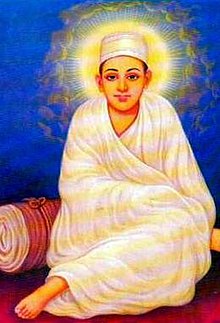Content deleted Content added
m en-IN |
103.42.174.142 (talk) WP:ELNO should generally avoid providing external links |
||
| Line 7: | Line 7: | ||
[[File:Dadudayal.jpg|thumb|Indian devotional image of Dadu]] |
[[File:Dadudayal.jpg|thumb|Indian devotional image of Dadu]] |
||
'''Dadu Dayal''' (1544–1603) was a [[Sant Mat|sant]] from [[Gujarat]], [[India]]. "Dadu" means brother, and "Dayal" means "the compassionate one". |
'''Dadu Dayal''' (1544–1603) was a [[Sant Mat|sant]] from [[Gujarat]], [[India]]. "Dadu" means brother, and "Dayal" means "the compassionate one". Dadu alludes to spontaneous (''[[sahaja]]'') bliss in his songs. Much of the imagery used is similar to that used by Kabir, and to that used by earlier [[Sahajiya]] [[Buddhist]]s and [[Nath]] [[yogi]]s. Dadu believed that devotion to God should transcend religious or sectarian affiliation, and that devotees should become non-sectarian or nipakh.<ref>[http://blog.sahajayoga.org/?p=26 Dadu on Realisation] {{webarchive|url=https://web.archive.org/web/20110812162422/http://blog.sahajayoga.org/?p=26 |date=2011-08-12 }} sahajayoga.org</ref> |
||
He was reputedly found by an affluent business man floating on the river Sabarmati. He later moved to [[Naraina]] (city), near [[Jaipur]] [[Rajasthan]], where he gathered around himself a group of followers, forming a sect that became known as the ''[[Dadupanth]]''. |
|||
This organization has continued in Rajasthan to the present-day and has been a major source of early manuscripts containing songs by Dadu and other [[North India]]n saints. Dadu's compositions were recorded by his disciple Rajjab and are known as the ''Dadu Anubhav Vani'', a compilation of 5,000 verses. Another disciple, [[Janagopal]], wrote the earliest biography of Dadu. |
|||
Dadu alludes to spontaneous (''[[sahaja]]'') bliss in his songs. Much of the imagery used is similar to that used by Kabir, and to that used by earlier [[Sahajiya]] [[Buddhist]]s and [[Nath]] [[yogi]]s. Dadu believed that devotion to God should transcend religious or sectarian affiliation, and that devotees should become non-sectarian or nipakh.<ref>[http://blog.sahajayoga.org/?p=26 Dadu on Realisation] {{webarchive|url=https://web.archive.org/web/20110812162422/http://blog.sahajayoga.org/?p=26 |date=2011-08-12 }} sahajayoga.org</ref> |
|||
Dadu had 100 disciples that attained ''[[samadhi]]''. He instructed additional 52 disciples to set up ashrams, 'Thambas' around the region to spread the Lord's word. Dadu ji spent the latter years of his life in Naraiana, a small distance away from the town of Dudu, near Jaipur city. Five thambas are considered sacred by the followers; Naraiana, Bhairanaji, Sambhar, Amer, and Karadala (Kalyanpura). Followers at these thambas later set up other places of worship. |
|||
==References== |
==References== |
||
{{reflist}} |
|||
<references/> |
|||
==Further reading== |
==Further reading== |
||
Revision as of 08:18, 28 August 2018

Dadu Dayal (1544–1603) was a sant from Gujarat, India. "Dadu" means brother, and "Dayal" means "the compassionate one". Dadu alludes to spontaneous (sahaja) bliss in his songs. Much of the imagery used is similar to that used by Kabir, and to that used by earlier Sahajiya Buddhists and Nath yogis. Dadu believed that devotion to God should transcend religious or sectarian affiliation, and that devotees should become non-sectarian or nipakh.[1]
References
- ^ Dadu on Realisation Archived 2011-08-12 at the Wayback Machine sahajayoga.org
Further reading
- Bakshi, S.R. and Mittra, Sangh eds. (2002) Sant Dadu Dayal: Encyclopaedia of Saints Series (Volume 25), Criterion Publications, New Delhi, India. ISBN 81-7938-029-7
External links